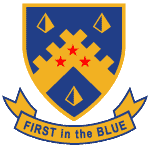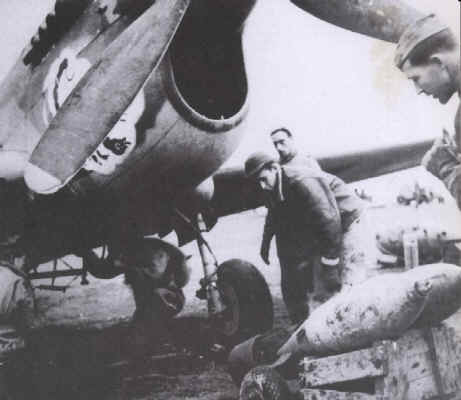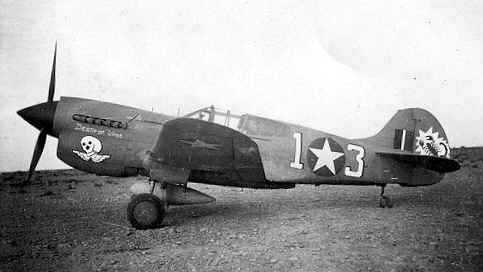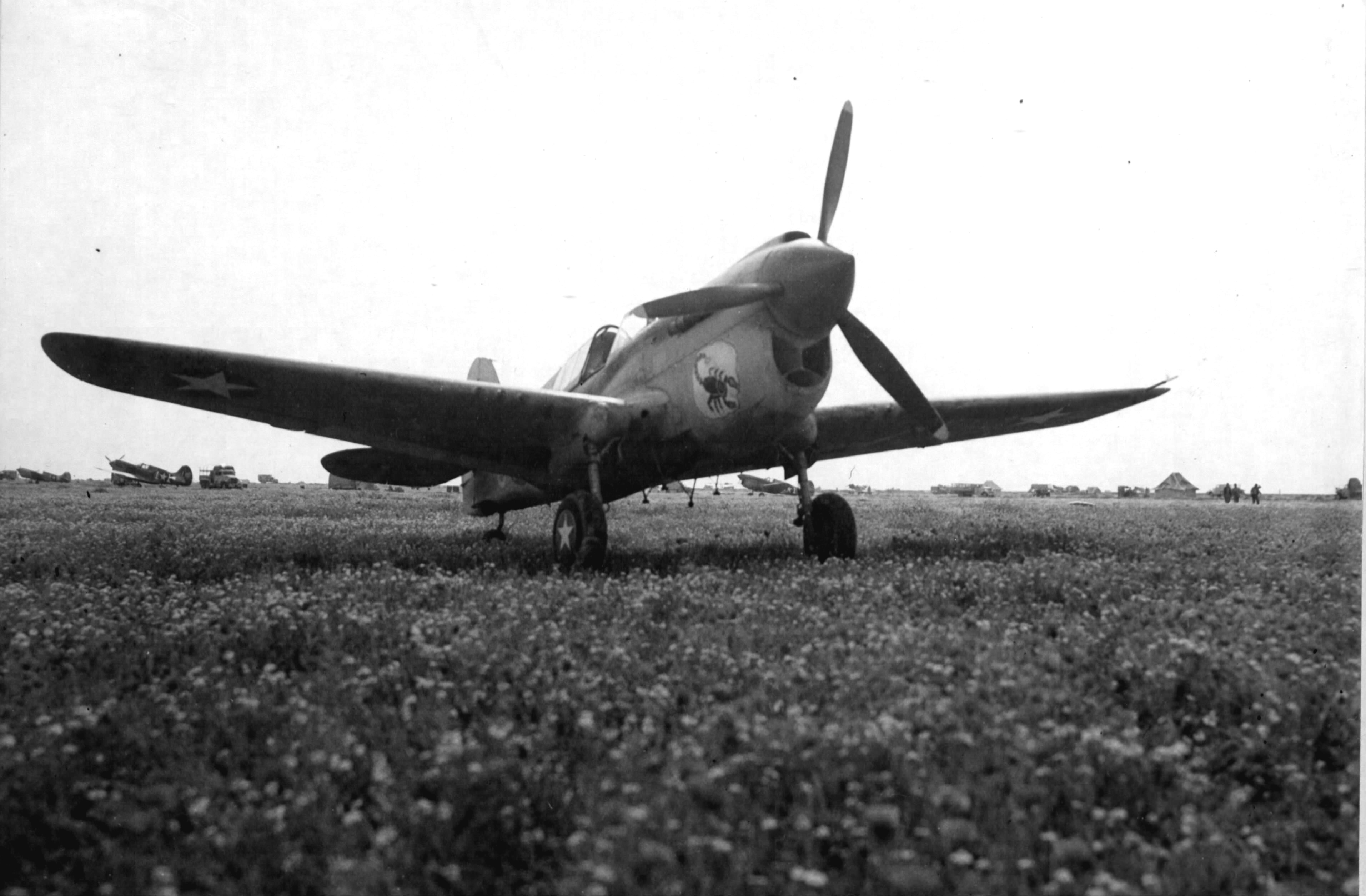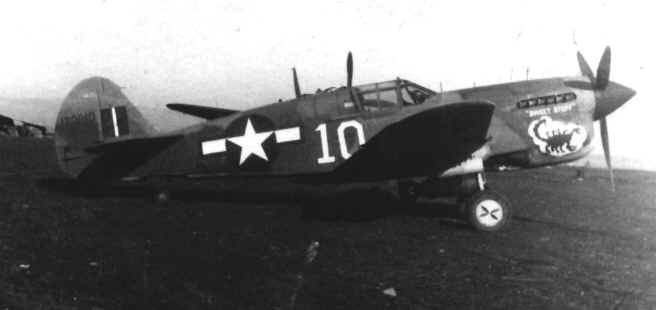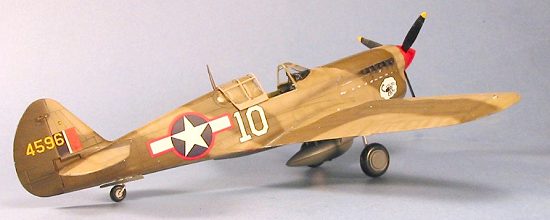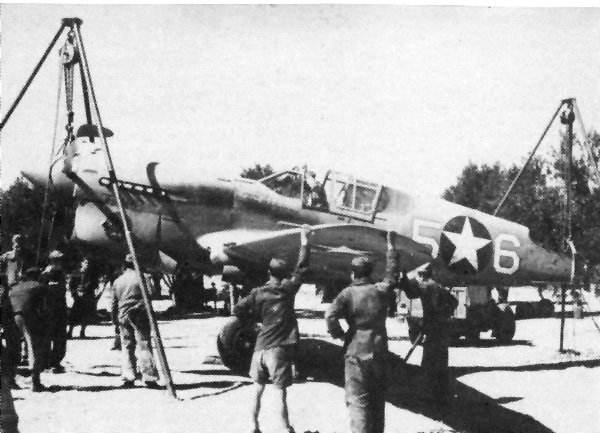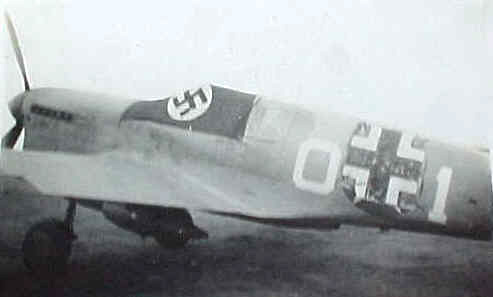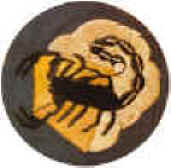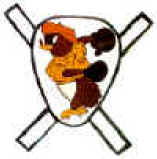57th FG
Motto "First in the Blue" the insignia was made when the 57th FG entered Africa and was
the first USAAF fighter group to do so.
It remained as the groups insignia until the end of the war.
The "Blue" does not refer to the sky but was the English designation for the desert.
Great 57thFG-64th FS, Picture source: http://www.flickr.com/photos/rooftop65/sets/72157601387267317/

May
10, 1942 -- Approximately 80 miles off coast of Accra, Africa. Commenced to
launch P-40s at 0800. Last flight at 1715. Takeoffs were fairly good.
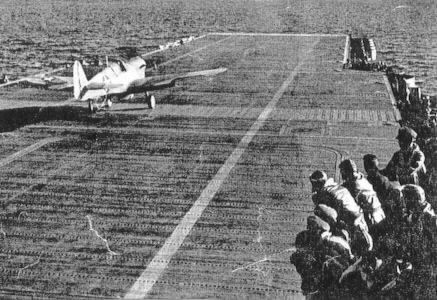
From 11 July until 19 July 1942 USS Ranger again made deliveries of P-40s. As CO of the 57th Fighter Group, Mears flew the first P-40 Warhawk off the deck of the carrier USS Ranger when the 57th went into action in North Africa in August '42. He was awarded the Distinguished Flying Cross and a Legion of Merit for the action.
Armourers prepare to shackle a 250 lb bomb beneath the belly of a P-40F Warhawk,
belonging to the 64th (Scorpions) FS, 57th FG USAAF, on an North African airfield.
64th Squadron - note the scorpion on the rudder, as opposed to the cowling where they usually were
5 Oct 1943: James H. Doolittle assumes command of the Twelfth Air Force.
Operating from the captured Foggia airfield.
Curtis P-40 fighter bombers of the 64th, 65th, 66th Fighter squadrons of the 57th HQ Fighter Group,
attack German trucks in the Termoli-Vasto area.
P-40K at Foggia, Italy
P-40, 64FS, 57FG in the left background is Curtiss P-40K-10-CU Warhawk, white 11, 64FS, 57FG, of George D Mobbs,
of particular interest in this photo are the National Stars appearance under each wing although this photo was taken in 1943
the Stars appearance in those locations help date the planes' arrival in country during 1942. Also note the lack of camouflage
2 tone paint scheme.
February 26, 1941. An extensive modification of aircraft marking specifications introduced the following basic changes: .
National Aircraft Insignia were added to both sides of the fuselage or hull and two were eliminated from the wings, leaving
one on the upper left and one on the lower right. . Branch of Service marking was moved from the fuselage to the vertical fin
above the Bureau Number, the figures were reduced in size and letters "U.S." omitted.
January 5, 1942, National Aircraft Insignia were returned to both right and left, upper and lower wing surfaces.
May 15, 1942, The red disc in the center of the National Aircraft Insignia and horizontal red and white rudder striping
were eliminated.
November 1942, In preparation for Operation Torch, the Allied invasion of French North Africa, an amendment
to Operation Memorandum Number 9, dated Sept. 25, 1942, was published by Allied Force Headquarters. It directed
that all American aircraft participating in the invasion display a yellow circle around the national aircraft insignia on each side
of the fuselage and on both lower wing surfaces.
February 1, 1943, One National Aircraft Insignia was again removed from the upper and lower wing surfaces, leaving one
on the upper left and one on the lower right.
June 28, 1943, A change in the National Aircraft Insignia added White rectangles to the left and right sides of the Blue
circular field to form a horizontal bar, and also added a Red border stripe around the entire design.
September 14,1943 The red border stripe was eliminated from the National Aircraft Insignia and use of Insignia Blue
was ordered in its place. Dates are when these changes were ordered, but remember that it was sometimes weeks or months
before the planes in the field were brought into compliance.
ASSIGNED COMBAT AIRCRAFT: Curtiss P-40F Warhawk, #43, "Miss Fury"
COMBAT UNITS: 65th Fighter Squadron "Fighting Cocks", 57th Fighter Group, 9th Air Force, MTO
Lt. Whittaker and the rest of the air echelon of the 57th FG arrived
to North Africa in the European-African-Middle Eastern Theatre of Operations aboard the aircraft
carrier, USS RANGER in June 1942. Whittaker's P-40F Warhawk was the second
plane launched off the RANGER's deck. All of the 57th Group's 72 Warhawks
launched from the carrier safely and without incident to land for
refueling at Accra, Gold Coast, then on to Wadi Sedina airfield near
Khartoum, Sudan where the pilots continued to train for combat.
The group moved for further training at Wadi Halfa airfield near Cairo,
Egypt in July 1942. The 57th FG then moved to their first base at
Muqueibila, Palestine and soon commenced operations attached to
112 Squadron RAF of 239 Wing, Desert Air Force. Lt. Whittaker
was among five pilots selected to train with the RAF at Alexandria,
Egypt and then pass on what he learned to U. S. pilots.
Later version of P-40 of the 57th FG-64th FS, note the moved number placement,
also the Star and Bar had the red coloured surround, 41-20010,
Curtiss P-40F-20-CU Warhawk, Sweet Stuff, coded number, 10, Pilot Arthur E. Exon
A modelers rendition note the differing tail numbers
41-14596, 64FS, 57FG, Curtiss P-40F-10-CU Warhawk
condemned inventory Jul 8, 1945
P40 of 65th FS of 57 FG, captured by Italians
Unknown to me captured P-40F
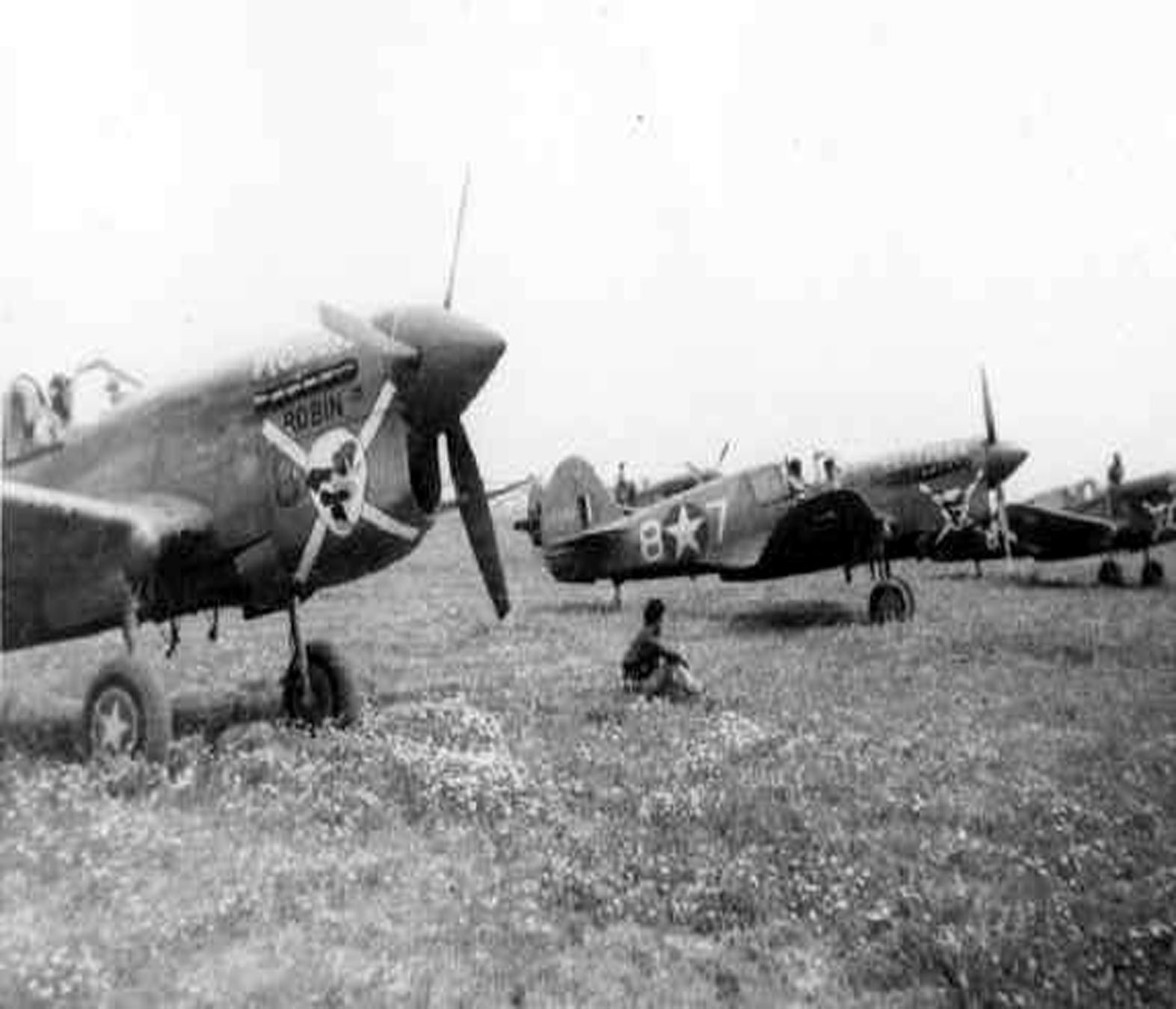
P-40F Warhawk
66th Fighter Squadron, 57th Fighter Group
United States Army Air Force
This P-40F-CU was assigned to the 9th Air Force in Africa during 1943.
|
Squadron Insignia: |
||||||
|
64th FS: The Black Scorpions |
65th FS: The Fighting Cocks After the 57th Fighter Group and its 3 squadrons were deactivated in 1945, they were reactivated on the Island of Shemya in the Aleutian Chain in 1946. |
66th FS: Originally designed by Sgt. Howard W Galipeau, during 1941 they thought they would be going to Iceland so he came up with a penguin body, (cold country), falcon claws (superior bird very fast and aggressive), boxing gloves ( a fair fighter), hat on backwards ( a challenger), a cigar stub ( looking for someone to knock it out of it's mouth). This tought looking dude was simply called "Oscar" the X was added in North Africa and the group became known as Exterminators Following World War II, the 66th Fighter Squadron was transferred to the Alaskan Air Command as an air defence unit. It remained there until 1957 when it was deactivated. While assigned to Alaska, the unit transitioned through several aircraft to include the P-51, F-80, F-94, and the F-89. |
||||
| Callsign | Kola | Hitchhike | Jackpot | |||
|
Plane Identification codes: |
#'s 10-39 |
#'s 40-69 |
#'s 70-99 |
Constituted as 57th Pursuit Group (Interceptor) on 20 Nov 1940. Activated on 15 Jan 1941. Trained with P-40's. Served as part of the defence force on the east coast after the Japanese attack on Pearl Harbor. Redesignated 57th Fighter Group in May 1942. Moved to the Middle East, Jul-Aug 1942. Trained with RAF. 57th Fighter Group USAAF (All units Detached to RAF)
http://www.af.mil/bios/bio_print.asp?bioID=5461&page=1
Harry
Albright French was born in Harrisburg, Ark., in 1915. He attended the local
schools in Harrisburg and graduated from the Harrisburg High School in 1932.
After spending two and one half years at Arkansas State College, and half a year
as a clerk-surveyor in the Public Works Administration, he entered the U.S.
Military Academy.
He received his commission at West Point as a second lieutenant June 11, 1940,
and was assigned to the Corps of Engineers with duty at the primary flying
school at Tuscaloosa, Ala. He graduated as a pilot at Maxwell in March 1941 and
was transferred to the Army Air Corps in the 8th Pursuit Group at Mitchel Field.
In May 1941, he was assigned to HQ of the 57th Fighter Group, and in
September moved to Bradley Field, Conn. At the start of World War II, he moved
with the 57th Group to Logan Airport, Boston, Mass., and qualified as a chief
controller in the Boston Defense Center.
From Boston, in July 1942 as a captain, he moved with the 57th to Palastine via
flying a P-40 off the U.S. Navy carrier "Ranger," off-shore at Accra,
Gold Coast, Africa, and then along the aircraft ferry route to Cairo, Egypt. He
was assigned to the IX Fighter Command, and in October 1943 as a lieutenant
colonel moved with it to England.
The
57th Fighter Group arrived in the Middle-East at Muqueibila, Palestine
,under the command of Col. Frank Mears, during July 1942. The air units then
began intensive training while the ground staff were still on their way. The
ground staff arrived on 17 August making the 57th Fighter Group fully
operational with seventy-two P-40F Warhawks in three squadrons, the 64th, 65th
and 66th Fighter Squadrons.
As soon as the Group arrived in the Middle-East it's fighter pilots were
integrated with the RAF fighter units in the area. During this period, the RAF
trained the USAAF pilots in tactics and operations in the desert. This gave the
U.S pilots valuable operational training without delaying combat. The 57th
Fighter Group were also dependant on the RAF for intelligence, briefing,
airfield facilities and servicing. Brigadier-General Auby C. Strickland (CO of
IX Fighter Command) commented that the success of the U.S fighter units in North
Africa was largely due to the excellent training and experience of the British
fighter units.
On 9 August, 1942, the 57th flew it's first mission. Five days later came the
first combat when six P-40s escorted 12 Baltimores and 11 Bostons to bomb El
Fuka airport. When the formation was attacked by five Bf-109s, the P-40s turned
into the attack and Lt. William O'Neil shot down two Bf-109s before being shot
down himself. He was rescued later in the sea.
Through August and September 57th Fighter Group continued training with the RAF
where they learnt formation and combat tactics over the desert. On 16
September the Group came under operational control of Air Officer Commanding,
Western Desert. The 64th and 65th FS became a separate wing in RAF 211 Group
while 66th FS was transferred to RAF 239 Wing on 6 October.
It would stay this way until the activation of U.S Desert Air Task Force on 22
October, 1942.
Following from:
In such wise was accomplished the long-range punishment of the retreat. During the pursuit to Agheila aerial combat
became something of a rarity, as neither German Air Force nor Italian Air Force could stay close in any force
to protect the army as had the RAF the previous June; for one thing, they had not the fuel. The 11th of November
marked an exception, when the Allied air forces collided with the GAF based at Gambut and El Adem.
The score reported that day: eleven Stukas, six Ju-52's, and five Me-109's, against six Kittyhawks and a P-40.
The 57th Fighter Group caught and destroyed three Stukas about to land at Gambut.95
The 57th's 66th Squadron had gone forward with the advance, under the operational control of No. 239 Wing, RAF.
Upon reaching Gazala it received orders to join the 64th and 65th Squadrons at Martuba.
By 20 November, therefore, in company with the RAF's 112 Squadron, the group was in action for the first time
as a tactical unit;96 between 6 November and the end of the month it
carried out the impressive total of 477 sorties
Began operations as a Fighter Group, Oct 1942. Took part in the Battle of El Alamein and, as part of Ninth AF, supported British Eighth Army's drive across Egypt and Libya, escorting bombers and flying strafing and dive-bombing missions against airfields, communications, and troop concentrations until the defeat of Axis forces in Tunisia in May 1943. Received a DUC for performance on 18 Apr 1943 when the group destroyed more than 70 of the enemy's transport and fighter planes in an aerial battle over the Gulf of Tunis.
Participated in the reduction of Pantelleria (May-Jun 1943) and the conquest of Sicily (Jul-Aug 1943). Received another DUC for front-line operations in direct support of British Eighth Army from the Battle of El Alamein to the capitulation of enemy forces in Sicily. Assigned to Twelfth AF in Aug 1943 and continued operations in the Mediterranean theater until the end of the war.
Supported British Eighth Army's landing at Termoli and subsequent operations in Italy (Oct 1943-Feb 1944) by flying dive-bombing, strafing, patrol, and escort missions. Converted to P-47's early in 1944 and used the new aircraft for interdictory operations in Italy, receiving a DUC for a series of devastating attacks on rail lines, trains, motor vehicles, bridges, and other targets in the Florence-Arezzo area on 14 Apr 1944. Participated in the French campaign against Elba in Jun 1944 and in the invasion of Southern France in Aug. Engaged in interdictory and support operations in northern Italy from Sep 1944toMay1945. Returned to the US in Aug 1945. Inactivated on 7 Nov 1945.
Activated in Alaska on 15 Aug 1946. Assigned to Alaskan Air Command. Redesignated 57th Fighter-Interceptor Group in Jan1950.Equipped successively with P-38, P-51, F-80, and F-94 aircraft. Inactivated in Alaska on 13 Apr 1953.
Squadrons. 64th: 1941-1945; 1946-1953. 65th: 1941-1945; 1946-1953. 66th: 1941-1945; 1946-1953.
Stations. Mitchel Field, NY, 15 Jan 1941; Windsor Locks, Conn, 19 Aug 1941;
Boston, Mass, 8 Dec 1941-. 1 Jul 1942;
FRIDAY, 10 JULY 1942, MEDITERRANEAN THEATER OF OPERATIONS [MTO, US Army, Middle East Air Force (USAMEAF)]: 57th Fighter Group, enroute from the US, is assigned to USAMEAF.
Muqeibile, Palestine, c. 20 Jul 1942;
MONDAY, 20 JULY 1942, MEDITERRANEAN THEATER OF OPERATIONS [MTO, US Army, Middle East Air Force (USAMEAF)]: Hal Bombardment Squadron and 9th Bombardment Squadron (Heavy) with 19 B-24s and 9 B-17s are organized as the 1st Provisional Group under Colonel Harry A Halverson's command at Lydda, Palestine. HQ 57th Fighter Group arrives at Muqueibile, Palestine from the US.
WEDNESDAY, 29 JULY 1942, MEDITERRANEAN THEATER OF OPERATIONS [MTO, US Army, Middle East Air Force (USAMEAF)]: 65th Fighter Squadron, 57th Fighter Group, arrives at Muqueibile, Palestine from the US with P-40s; first mission is 7 Oct.
WEDNESDAY, 5 AUGUST 1942, MTO (USAMEAF): Lieutenant General Lewis H Brereton, in his first strategic estimate of the Middle Eastern war, indicates that the 3 major objectives for the Allied Air Forces are to assist in the destruction of General Erwin Rommel's Afrika Korps by support to ground troops, secure sea and air communications on and over the Mediterranean, and carry out a sustained air offensive against Italy and against oil installations at Ploesti, Rumania and in the Caucasus, if the latter should fall under Axis control. Unit moves: 65th Fighter Squadron, 57th Fighter Group, from Muqueibile, Palestine to Cyprus with P-40s; 345th Bombardment Squadron (Heavy) arrives at Ramat David, Palestine from the US with B-24s; first mission is 12 Aug.
SUNDAY, 16 AUGUST 1942, MTO (USAMEAF): Personnel strength is greatly increased and supply and maintenance prospects are much improved by the arrival of ground echelons of the 57th Fighter Group, 12th Bombardment Group (Medium), 98th Bombardment Group (Heavy) and 323d Service Group.
MONDAY, 17 AUGUST 1942, MTO (USAMEAF): B-25s of the 81st Bombardment Squadron (Medium) hit stores, depot and tank repair shops at Matruh, Egypt. This marks the debut of the B-25s of the 12th Bombardment Group (Medium) in the Middle East.
WEDNESDAY, 19 AUGUST 1942, MTO (USAMEAF): 64th and 66th Fighter Squadrons, 57th Fighter Group, arrive at Muqueibile and Beit Daras, Palestine respectively from the US with P-40s; first mission is 7 Oct.
SATURDAY, 29 AUGUST 1942, MTO (USAMEAF): B-24s fail to locate shipping near Crete and return without bombing. B-25s bomb a landing ground during the night of 29/30 Aug. 65th Fighter Squadron, 57th Fighter Group, moves from Cyprus to Muqueibile, Palestine with P-40s; first mission is 7 Oct.
MONDAY 31 AUGUST 1942, MTO (USAMEAF): B-25s attack aircraft on a landing ground, and B-24s raid the harbor at Tobruk, Libya. P-40s of the 66th Fighter Squadron, 57th Fighter Group, escort RAF bombers during raid on Maryut, Egypt. B-25s, in conjunction with RAF Bostons, attack troop concentrations and military vehicles as the battle of Alam-el-Halfa begins along the El Alamein line.
TUESDAY, 1 SEPTEMBER 1942, MEDITERRANEAN THEATER OF OPERATIONS [MTO, US Army, Middle East Air Force (USAMEAF)]: B-24s attack the harbor at Candia, Crete, scoring several direct hits on 1 vessel and hitting others. 2 squadrons of the 57th Fighter Group fly escort missions and sweeps with the Royal Air Force (Probably RAF112 Squadron (The Sharkmouthed P-40 Squadron)). B-25s, in conjunction with RAF light bombers, hit trucks and tanks in the battle area of Alam-el-Halfa, Egypt.
WEDNESDAY, 2 SEPTEMBER 1942, MEDITERRANEAN THEATER OF OPERATIONS [MTO, US Army, Middle East Air Force (USAMEAF)]: B-24s hit docks and jetties at Tobruk, Libya; B-25s bomb aircraft and a landing ground and, with the RAF, attack troops and vehicles in the battle area around Alamel-Halfa, Egypt ridge; P-40s fly escort and sweep missions over the battle area in conjunction with the RAF. (57th FG only USAAF P-40 unit in MTO at this time)
THURSDAY, 3 SEPTEMBER 1942, MEDITERRANEAN THEATER OF OPERATIONS [MTO, US Army, Middle East Air Force (USAMEAF)]: B-24s attack a convoy at sea; B-25s hit troop concentrations, vehicles, and airfield installations in the battle area of Alam-el-Halfa, Egypt and behind enemy lines; P-40s, mostly operating with the RAF, escort bombers and engage fighters in combat, claiming at least 1 shot down.
FRIDAY, 4 SEPTEMBER 1942, MEDITERRANEAN THEATER OF OPERATIONS [MTO, US Army, Middle East Air Force (USAMEAF)]: B-24s, in conjunction with the RAF and the Royal Navy (RN), attack a convoy at sea; 2 merchant ships are reported sunk and 1 left burning. B-25s and RAF Bostons, repelling counterattacks during the Alam-el- Halfa, Egypt battle, hit troop concentrations and vehicles, while P-40s, operating with the RAF, escort bombers and engage in combat over the battle area, claiming 1 fighter destroyed.
SATURDAY, 5 SEPTEMBER 1942, MEDITERRANEAN THEATER OF OPERATIONS [MTO, US Army, Middle East Air Force (USAMEAF)]: B-24s strike shipping and dock area in Candia Bay, Crete. In Egypt, P-40s escort RAF bombers over the the battle area SE of Alam-el-Halfa ridge near Rayil Dayr Ar Depression as the enemy offensive falters and is pushed back.
SUNDAY, 6 SEPTEMBER 1942, MEDITERRANEAN THEATER OF OPERATIONS [MTO, US Army, Middle East Air Force (USAMEAF)]: In Egypt, P-40s fly an offensive sweep over the battle area near the Rayil Dayr Ar Depression, claiming 3 Ju 87s shot down; P-40s also escort RAF bombers and fly 2 interceptor missions.
FRIDAY, 11 SEPTEMBER 1942, MEDITERRANEAN THEATER OF OPERATIONS [MTO, US Army, Middle East Air Force (USAMEAF)]: P-40s fly an uneventful sweep with the RAF during a lull after the Battle of Alam-el-Halfa, Egypt.
SATURDAY, 12 SEPTEMBER 1942, MEDITERRANEAN THEATER OF OPERATIONS [MTO, US Army, Middle East Air Force (USAMEAF)]: P-40s fly 3 uneventful scramble missions along the frontlines.
MONDAY, 14 SEPTEMBER 1942, MEDITERRANEAN THEATER OF OPERATIONS [MTO, US Army, Middle East Air Force (USAMEAF)]: B-24s attack shipping at Suda Bay, Crete, setting 1 vessel afire, while other B-24s hit Tobruk, Libya; P-40s fly a sweep with the RAF over the frontlines.
TUESDAY, 15 SEPTEMBER 1942, MEDITERRANEAN THEATER OF OPERATIONS [MTO, US Army, Middle East Air Force (USAMEAF)]: A lone B-24 drops 1 bomb on a tanker in Suda Bay, Crete. B-24s bomb behind the enemy lines while P-40s, with the RAF, fly escort and carry out a scramble missions over the area W of El Alamein, Egypt.
FRIDAY, 23 OCTOBER 1942, MEDITERRANEAN THEATER OF OPERATIONS [MTO, US Army, Middle East Air Force (USAMEAF)]: B-17s and B-24s sent to attack Candia, Crete and Bengasi, Libya turn back short of the target due to bad weather. The El Alamein, Egypt offensive by the British Eighth Army begins at 2140 hours local with an artillery barrage by 1,000+ guns aimed at enemy batteries; at 2200 hours, the barrage switches to the enemy forward positions as British troops move forward; heavy fighting continues during the night of 23/24 Oct.
SATURDAY, 24 OCTOBER 1942, MEDITERRANEAN THEATER OF OPERATIONS [MTO, US Army, Middle East Air Force (USAMEAF)]: In Egypt, B-25s support the British Eighth Army Offensive W of El Alamein between the Mediterranean Sea and the Qattara Depression as 30 Corps, with 4 divisions in assault, secures 2 corridors through enemy minefields on the British N flank, while 13 Corps on the S flank breaks through minefields N of Himeimat and establishes a small bridgehead; the B-25s hit troop concentrations, tent areas, gun emplacements, and vehicles; P-40s, working with the RAF and South African Air Force (SAAF), escort medium and light bombers and hit motor transports and tanks
SUNDAY, 25 OCTOBER 1942, MEDITERRANEAN THEATER OF OPERATIONS [MTO, US Army, Middle East Air Force (USAMEAF)]: The Battle of El Alamein continues as General Bernard L Montgomery decides to make the main effort on the N flank of 30 Corps; the Australian 9 Division drives N toward the coastal road to Rahman; B-25s disperse motor transport and other targets in support of ground forces; P-40s on escort attack vehicles and other targets; fighters claim several airplanes destroyed in combat; and B-24s sent to bomb the harbor at Bengasi, Libya and a convoy at sea fail to reach targets as bad weather prevails.
MONDAY, 26 OCTOBER 1942, MEDITERRANEAN THEATER OF OPERATIONS [MTO, US Army, Middle East Air Force (USAMEAF)]: The momentum of the British drive decreases in the El Alamein, Egypt battle; 30 Corps takes Kidney Ridge, and General Bernard L Montgomery decides to regroup for a break-out assault; Allied aircraft continue strong support to ground forces and disperse enemy concentrations preparing for an attack; B-25s hit transport, troop concentrations, and tanks; P-40s fly sweeps over the El Daba area, Egypt and attack motor transport and other targets; enemy air action increases and considerable aerial combat ensues; US fighters claim 4 airplanes shot down. 30+ B-17s and B-24s attack shipping off the coast of Libya.
On
the 26th the Axis counter-attacked the British infantry on the ground, and
counter-attacked the Allied air forces in the skies over the desert. 12th Bomb
Group flew 18 sorties on this day, while 57th Fighter Group flew 72. In the air
the Axis lost six Bf 109s, eight MC 202s and three Ju 87 'Stukas'. Four Allied
fighters failed to return. Also on this day the heavy bombers made an appearance
over Tobruk to hit convoys.
On the 27th the 57th Fighter Group used a new tactic in attacking German
airfields. Taking off in darkness, the P-40s attacked Fuka at low-altitude and
strafed the airfield destroying several planes, trucks and tents. 65th and 64th
squadron P-40s engaged in heavy combat later in the day when, while on a
fighter-bomber mission, encountered twenty CR-42s, twenty Ju 87s and twenty Bf
109s. The P-40s turned into the enemy claiming seven destroyed, three probably
destroyed and three damaged without loss.
WEDNESDAY, 28 OCTOBER 1942, MEDITERRANEAN THEATER OF OPERATIONS [MTO, US Army, Middle East Air Force (USAMEAF)]: B-17s, dispatched to attack a convoy at sea, fail to locate the target but attack cruisers in Pylos Bay, Greece; B-25s attack tanks, motor transports, and landing grounds; P-40s fly medium and light bomber escort, bomb and strafe landing grounds and other targets, and engage aircraft in combat, mostly in the area between El Alamein and El Daba, Egypt; fighters claim 3 Bf 109s destroyed; attacks by US and RAF aircraft cause the enemy to abandon a plan for a counterattack on Kidney Ridge.
On the 28th Allied fighters claimed nine enemy fighters destroyed, four of these were claimed by 57th Fighter Group. The second phase of the British offensive began on this night aimed to drive into the enemy flank and cut his supply. The Allied air forces kept pressure on the Axis air forces and ate away at their supplies.
Egypt, 16 Sep 1942;
WEDNESDAY, 16 SEPTEMBER 1942, MEDITERRANEAN THEATER OF OPERATIONS [MTO, US Army, Middle East Air Force (USAMEAF)]: Major General Lewis H Brereton is officially assigned to the Middle East as a result of pressure from Major General Clayton L Bissell, new Commanding General Tenth Air Force, for clarification of the status of Brereton and other key staff officers and combat crews who had gone from India to the Middle East in Jun and Jul 42. HQ 57th Fighter Group and the 64th, 65th and 66th Fighter Squadrons move from Muqeibile and Beit Daras, Palestine to Landing Ground 174, Egypt with P-40s.
THURSDAY, 17 SEPTEMBER 1942, MEDITERRANEAN THEATER OF OPERATIONS [MTO, US Army, Middle East Air Force (USAMEAF)]: During the night of 16/17 Sep, B-24s bomb Bengasi, Libya harbor; during the day, targets for B-24s are in Greece: shipping in Pylos Bay and shipping and piers near Sphakia, and in Khalones and Pylos Island. P-40s make an offensive sweep with the RAF over the front lines.
TUESDAY, 29 SEPTEMBER 1942, MEDITERRANEAN THEATER OF OPERATIONS [MTO, US Army, Middle East Air Force (USAMEAF)]: B-24s hit harbor installations at Suda Bay, Crete. P-40s fly an offensive sweep over the battle area, and carry out an interception mission against Ju 87s over the frontline near El Alamein, Egypt. The 434th Bombardment Squadron (Medium), 12th Bombardment Group (Medium), moves from Ismailia to Landing Ground 88, Egypt with B-25s
WEDNESDAY, 7 OCTOBER 1942, MEDITERRANEAN THEATER OF OPERATIONS [MTO, US Army, Middle East Air Force (USAMEAF)]: B-24s score 7 direct hits on a tanker and 8 on fuel installations at Suda Bay, Crete. 66 P-40s escort bombers over the battle area W of El Alamein, Egypt. (First combat patrol as the 57th Fighter Group)
FRIDAY, 9 OCTOBER 1942, MEDITERRANEAN THEATER OF OPERATIONS [MTO, US Army, Middle East Air Force (USAMEAF)]: B-24s strike shipping and harbor facilities at Bengasi, Libya; P-40s fly escort and strafe a landing ground W of El Daba, Egypt and emplacements in the battle area W of El Alamein, Egypt.
TUESDAY, 13 OCTOBER 1942, MEDITERRANEAN THEATER OF OPERATIONS [MTO, US Army, Middle East Air Force (USAMEAF)]: P-40s fly a fighter sweep, patrol, and interception missions W of El Alamein, Egypt; fighters claim 2 Bf 109s destroyed and 1 damaged.
WEDNESDAY, 14 OCTOBER 1942, MEDITERRANEAN THEATER OF OPERATIONS [MTO, US Army, Middle East Air Force (USAMEAF)]: B-17s hit shipping at Tobruk, Libya, scoring 2 direct hits on a large vessel and demolishing a smaller ship moored alongside; P-40s fly patrols, reconnaissance and interception missions between El Alamein and Burg el Arab, Egypt.
THURSDAY, 22 OCTOBER 1942, MEDITERRANEAN THEATER OF OPERATIONS [MTO, US Army, Middle East Air Force (USAMEAF)]: Advance US Air HQ, previously attached to the RAF Advanced Air HQ, Western Desert, to gain field experience, becomes HQ of Desert Air Task Force (DATF), located at Burg el Arab, Egypt, with Lieutenant General Lewis H Brereton as Commanding General and Major General Elmer E Adler attached with advance HQ of Air Service Command; the Chief of Staff of the DATF is Brigadier General Auby C Strickland. B-25s bomb dispersed aircraft. In Egypt, P-40s escort bombers, attack tent areas and motor transport along the coastal road near El Hammam, fly reconnaissance and fighter sweeps W of El Daba, and bomb artillery positions; P-40s claim 2 fighters destroyed. B-17s sent to hit Candia, Crete abort because of weather.
THURSDAY, 29 OCTOBER 1942, MEDITERRANEAN THEATER OF OPERATIONS [MTO, US Army, Middle East Air Force (USAMEAF)]: B-24s and B-17s strike Maleme Airfield, Crete. In Egypt, B-25s bomb landing grounds, motor transports, and tanks; P-40s fly escort, then bomb and strafe road E of El Daba, and attack troop concentration and vehicles; in view of the strong German reinforcements on his N flank near the coast, General Bernard L Montgomery alters the breakout plan; instead of pushing W along coast, he decides to shift the point of advance S in order to attack against Italian troops.
FRIDAY, 30 OCTOBER 1942, MEDITERRANEAN THEATER OF OPERATIONS [MTO, US Army, Middle East Air Force (USAMEAF)]: In Crete, B-24s bomb Maleme Airfield and 1 B-24 bombs the main jetty in Suda Bay. In Egypt, B-25s attack landing grounds at Fuka-Bagush and El Daba; P-40s fly escort; the British Eighth Army sends 9 Australian Division N to the sea and then E, trapping a large force in a pocket, as Allied aircraft provide excellent support; enemy tanks breaking through from the W, however, enable most of the surrounded force to escape.
SATURDAY, 31 OCTOBER 1942, MEDITERRANEAN THEATER OF OPERATIONS [MTO, US Army, Middle East Air Force (USAMEAF)]: B-25s hit a landing ground; they claim 1 fighter shot down while P-40s flying escort claim 3; B-24s sent to bomb the Maleme dispersal area on Crete fail to locate the target because of overcast. HQ 376th Bombardment Group (Heavy) and the 512th, 513th, 514th and 515th Bombardment Squadrons are activated at Lydda, Palestine with B-24s replacing the 1st Provisional Group; the 376th is intended to become part of an Anglo-American air force to be sent to the Caucasus area to aid the USSR, but the plan falls through and the 376th remains in the Middle East.
Libya, 12 Nov 1942;
THURSDAY, 12 NOVEMBER 1942, HQ 57th Fighter Group and the 65th Fighter Squadron move from Egypt to Libya with P-40s
FRIDAY, 13 NOVEMBER 1942, NE AFRICA (Ninth Air Force): Tobruk, Libya falls to 10 Corps of the British Eighth Army. The 64th and 66th Fighter Squadrons, 57th Fighter Group, move from Egypt to Libya with P-40s.
Tunisia, Mar 1943;
SUNDAY, 15 NOVEMBER 1942, NE AFRICA (Ninth Air Force): In Libya, B-24s from 2 groups are sent to bomb Tripoli, but unfavorable weather prevents them from reaching the target; 1 group bombs a motor convoy, as well as an airfield and crowded roads in the Bengasi area; P-40s fly sweeps and fighter-bomber missions against the retreating enemy W of Martuba; Martuba Airfields are captured by British 10 Corps and are soon occupied by the 57th Fighter Group.
THURSDAY, 10 DECEMBER 42, EASTERN MEDITERRANEAN (Ninth Air Force) P-40s of the 57th Fighter Group claim one enemy aircraft destroyed.
SUNDAY, 13 DECEMBER 1942, EASTERN MEDITERRANEAN (Ninth Air Force) In Libya, aircraft of the Western Desert Air Force, including more than 100 P-40s, fly strafing and bombing missions against ground forces which begin withdrawing from El Agheila during the early morning. The 57th Fighter Group claims two Bf 109s for the loss of one P-40. The British 51 Division penetrates the eastern defenses of El Agheila.
MONDAY, 14 DECEMBER 1942, EASTERN MEDITERRANEAN (Ninth Air Force) In Libya, P-40s continue to pound retreating German forces east of El Agheila. The 57th Fighter Group claims one enemy aircraft destroyed. As the British 7 Armored and 51 Infantry Divisions push west, the New Zealand 2 Division pushes southwest and rounds the enemy's right flank, then heads northwest towards the coast to cut off their retreat.
FRIDAY, 5 MARCH 1943, The 66th Fighter Squadron, 57th Fighter Group with P-40s transfers from Libya to Tunisia
TUESDAY, 9 MARCH 1943, HQ 57th Fighter Group and it's 65th Fighter Squadron with P-40's transfer from Libya to Tunisia.
WEDNESDAY, 10 MARCH 1943, The 64th Fighter Squadron, 57th Fighter Group with P-40's transfers from Libya to Tunisia.
SATURDAY, 13 MARCH 1943, In Tunisia, 34 P-40s of the 57th Fighter Group fly top cover and fighter sweep, and engage about 25 Bf 109 fighters in combat; we claim 4 destroyed; we lose 4 including 3 pilots.
Malta, Jun 1943;
SUNDAY, 27 JUNE 1943, EASTERN MEDITERRANEAN (Ninth Air Force), HQ 57th Fighter Group and it's 64th, 65th and 66th Fighter Squadrons transfer with P-40's from Tunisia to Malta.
Sicily, Jul 1943; Southern Italy,
MONDAY, 19 JULY 1943, EASTERN MEDITERRANEAN (Ninth Air Force), The 64th, 65th and 66th Fighter Squadrons, 57th Fighter Group, transfer with P-40's from Malta to Sicily. (Pachino (Sicily), RAF Servicing Commandos, On the 19th Kittyhawks of No. 239 Wing were looked after as they landed and the same thing was done on the following day for Warhawk aircraft of the 57th Pursuit Group, United States Air Force. In both cases the aircraft were followed on the same evening by the advanced parties of their own ground crews. http://www.bbc.co.uk/dna/ww2/A7713443)
Sep 1943; Gioia Airfield, Italy, c. 25 Sep 1943; Foggia, Italy, Oct 1943; Amendola, Italy, c. 27 Oct 1943; Cercola, Italy, Mar 1944; Corsica, Mar 1944; Ombrone Airfield, Italy, Sep 1944; Grosseto, Italy, Sep 1944; Villafranca di Verona, Italy, 29 Apr 1945; Grosseto, Italy, 7 May 1945; Bagnoli, Italy, Jul-5 Aug 1945; Drew Field, Fla, 21 Aug-7 Nov 1945. Shemya, Alaska, 15 Aug 1946; Elmendorf AFB, Alaska, Mar 1947-13 Apr 1953.
Commanders. Maj Reuben C Moffat, c. 15 Jan 1941; Maj Clayton B Hughes, unkn; Maj Minthorne W Reed, 12 Dec 1941; Lt Col Frank H Mears, 1942; Col Arthur G Salisbury, 20 Dec 1942; Col Archibald J Knight, 23 Apr 1944; Lt Col William J Yates, 23 May 1945-unkn. Maj Benjamin H King, 15 Aug 1946; Lt Col Gilmore V Norris, 26 Dec 1946; Lt Col Harry L Downing Jr, 10 Jan 1947; Col Morton D Magoffin, 14 Nov 1947; Col Bingham T Kleine, 22 Jan 1949; Col John W Mitchell, c. Nov 1950; Lt Col Ollie O Simpson, 19 Nov 1951; Col Thomas H Beeson, 21 Nov 1951; unkn, 1 Jul 1952-13 Apr 1953.
Campaigns. Air Combat, EAME Theater; Egypt-Libya; Tunisia; Sicily; Naples-Foggia; Rome-Arno; Southern France; North Apennines; Po Valley.
Decorations. Distinguished Unit Citations: North Africa and Sicily, 24 Oct 1942-17 Aug 1943; Tunis and Cape Bon Area, 18 Apr 1943; Italy, 14 Apr 1944.
Insigne. Shield: Azure, on a chevron embattled or, between three pyramids of the last, as many mullets gules. Motto: First In The Blue. (Approved 2 Feb 1950.)
